

MICHAEL and JEANNIE
|
|
on Shutterfly or our 108 Photos with Captions on Facebook
|
About a year ago we learned that our friend Kenneth Mills was arranging a tour of biblical sites around the Aegean Sea to be led by Harding University Bible professor and archeologist Dr. Dale Manor. Though this would be Michael’s fifth and Jeannie’s fourth visit to Athens, we decided God was providing an educational and faith-building opportunity that was too good for us to pass up. By departure time, the group consisted of 43 Christians with similar interests. Several, if not most, were fellow Harding alumni.
Here is the list of biblical sites in the order that we visited. The verse where each place was first mentioned in the New Testament is included in parenthesis.
|
|
20 May 2019, Monday
Thanks once again to our early-morning-friend, Robertta, for taking us to the Fort Smith airport on time to catch our 6:25 a.m. Delta Airlines flight to Atlanta. Changing planes, we arrived as scheduled in New York. As planned, we met a fellow traveler, Kathy from Ohio, who joined our Delta flight to Greece, departing about 5 p.m.

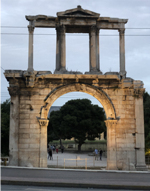 21 May 2019, Tuesday
21 May 2019, Tuesday
Our overnight flight landed about 10 a.m. in Athens, Greece. There we three met Peter and Sue from Connecticut, who arrived about 2 hours later. We enjoyed getting to know them at lunch in the airport. The remainder of our tour group arrived about 2 p.m. Christian Nicolaides from Aristotle Travel welcomed us to Greece. While being transported by bus to our hotel, we were given a panoramic city tour and introduction to Athens by our friend Dino Roussos, owner of Aristotle Travel. After settling into our hotel room, Jeannie and Michael explored the immediate area around the hotel, including the Arch of Hadrian and a few shops in the Plaka. We were asleep soon after supper, hoping to lessen the effects of jet lag.
After a buffet breakfast in our hotel, we met our excellent guide, James Nikolopuolos, who had accompanied us as guide during our previous visit to Athens in 2011. We were once again impressed with his knowledge of history, Greek culture, and his remarkable ability to discuss related biblical details. Our bus transported us first to the 1896 Olympic stadium, where we stopped for photos and lessons about the ancient Olympic games. Afterward, we were taken to the Acropolis. When we climbed to the top, we admired the world’s most famous temple, the Parthenon, built without slave labor in 447–432 B.C. to honor Athena, patron goddess of Athens. After a short devotional on nearby Mars’ Hill (made famous by Acts 17:19-34), our group walked down the hill for lunch. We then regrouped and walked with our guide through the ancient Agora (“marketplace” in English) and its small museum. 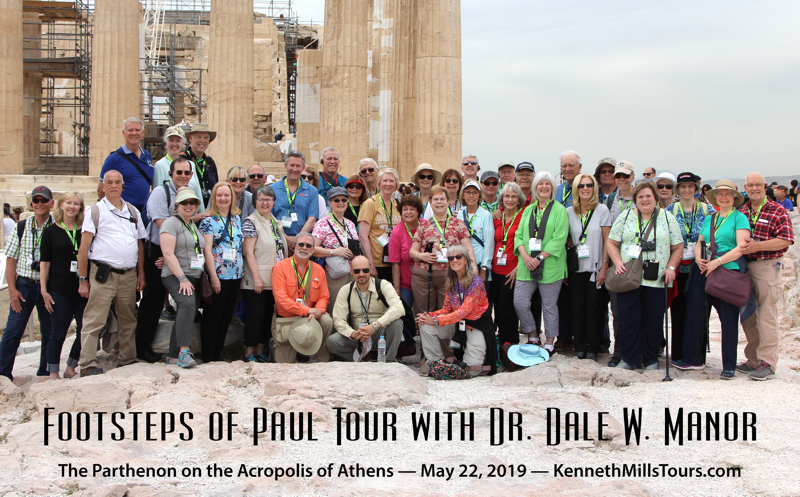 While Jeannie and some new friends walked back to the hotel to shop through the Plaka, the rest of the group was taken by bus back to Hotel Parthenon. After our buffet supper in the hotel, Michael and Jeannie skipped the provided dessert and ordered baklava at a nearby restaurant.
When we reached Corinth on Thursday morning, our chartered bus parked for us to walk across the high bridge over the canal that connects the Ionian and the Aegean Seas. By mid morning we arrived at the ruins of old Corinth, where our very qualified guide, James, accompanied us around the museum and the remains of the ancient city and discussed numerous ties to New Testament Scripture. We marveled at the stone inscribed with “Erastus,” whom Paul called “the city treasurer” in Romans 16:23.  ancient Corinth Before lunch we drove by what remains of the ancient port city of Cenchrea. We ate where we watched a low bridge drop deep below the water as ships passed through the canal. After returning to the hotel, Michael and Jeannie visited several shops in the Plaka without finding any souvenirs we needed. After the hotel buffet supper, a few of us ate gelati in the Plaka. (During the trip we sampled gelato at several ice cream shops, but found none to be as good as what we enjoy in Italy, where it was invented.)
The first island stop on our Aegean cruise was Mykonos. We were on the island between 7 and 9:30 p.m. Being along the shipping route from Egypt, windmills here were used in ancient times to grind wheat into flour before transporting on to Rome. Our guide led us through the very narrow and crowded streets to see several windmills. She let us find our own way back to the bus stop for return to the ship. Rather than having a late supper on the ship, the two of us stopped along the way for a good meal at an Italian restaurant. |

|
25 May 2019, Saturday
On Saturday morning we were up by 5 a.m. Our cruise ship docked at Kusadasi, Turkey, about 6:30 a.m. By 8:30 we were inside the archaeological ruins of ancient Ephesus. This Greco-Roman city was home to the Temple of Artemis, one of the Seven Wonders of the Ancient World. Nothing identifiable remains of that temple, but there were plenty of other structures to see. We saw the amphitheater mentioned in Acts 19:29. Regrettably, the amphitheater was not open to visitors while we were there. 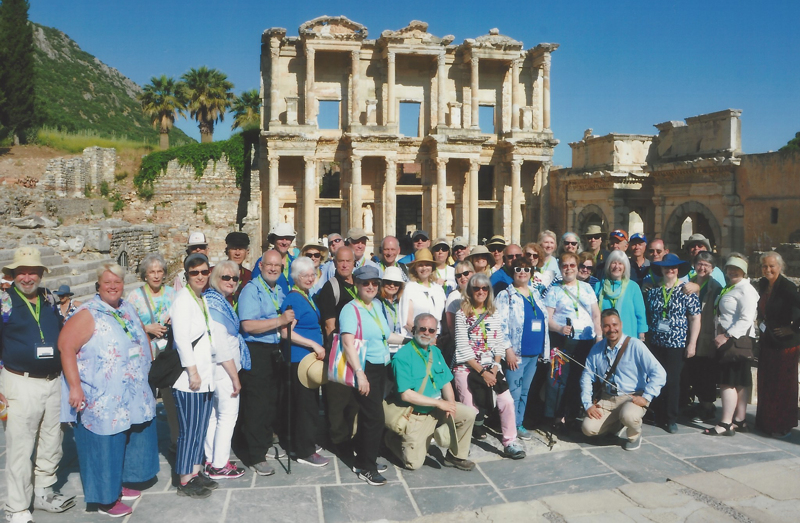 tour group at ancient library in Ephesus
We had lunch on the ship about 12:30. At 2 p.m. many of us were on deck to watch our ship pass through the Mycale Strait, between Turkey and the Greek island of Samos. Europe was on the right and Asia was on our left, just 1 mile wide at its narrowest point. Jeannie then enjoyed a manicure while Michael took a brief nap. The group met with Karen, our tour captain, at 4 p.m. for instructions about our next port of call.
|

 We boarded a tender about 5:30 p.m. for the 6-minute boat ride to the island of
Patmos. There we were bused to the “Monastery of St. John the Theologian.” Then we
visited the “Cave of the Apocalypse,” the traditional site where the exiled Apostle
John wrote “Revelation.”
We boarded a tender about 5:30 p.m. for the 6-minute boat ride to the island of
Patmos. There we were bused to the “Monastery of St. John the Theologian.” Then we
visited the “Cave of the Apocalypse,” the traditional site where the exiled Apostle
John wrote “Revelation.”
Our bus took us to the archaeological ruins of the palace of Knossos, from where King Minos ruled. It was also the legendary site of the Minotaur and the Labyrinth built by Daedalus. Knossos was the center of the ancient Minoan civilization, which was apparently devastated by the massive volcanic activity about 1450 B.C. at Santorini, 77 miles away. We were back onboard the ship for lunch. Our group met for a short Sunday worship service at 1:30.
As our group walked through the Delphi museum, our guide pointed out the significance of the more important artifacts. We saw the inscriptions that were found a little over a century ago in Delphi, providing the year for “When Gallio was proconsul of Achaia, ...” as Luke wrote in Acts 18:12. After that discovery, the events in the New Testament book of “Acts of the Apostles” could be accurately dated.
Leaving our hotel at 8:30, we were driven to the top of the nearby mountains where we visited two of the famous Meteora monasteries of the Byzantine period. After we descended the mountains, we watched a live demonstration of how Greek Orthodox icons are made. We stopped for lunch before leaving the area about 2:00.
In Berea we stopped at 6 o’clock for half an hour at the impressive monument to the Apostle Paul. There are no tourist-worthy archaeological digs to see. We arrived around 7:30 p.m. at the Grand Hotel Palace in Thessalonica (called “Thessaloniki” and “Salonica” by modern Greeks).
We stopped by the bay for lunch in Kavala (“cavallo” means “horse” in Italian and may or may not be the source of its name). During the Middle Ages, the town was called Christoupolis (“city of Christ”). In Paul’s day, it was called Neapolis (“new city”). Built to serve as the seaport for Philippi, it was here in Macedonia on his second missionary journey that Paul first set foot in Europe. (See Acts 16:11.) We ate lunch beside the bay in Kavala. As we were entering the ruins of ancient Philippi at 2 o’clock, our group serendipitously and excitedly met a group of Harding University students coming out. Philippi was named by Philip II of Macedon in 356 B.C. Though we were all hot and sweaty rather quickly, we found the archaeological site quite fascinating. We saw the remains of the oldest Christian church building yet discovered in Europe. An inscription in the mosaic floor of this octagonal building made it possible to accurately date the structure to 343 A.D. This unique early design had the Christians facing one another as they worshiped. 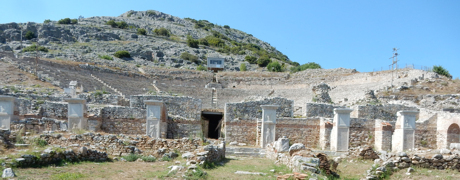 amphitheater in ancient Philippi Before leaving the area we stopped at the traditionally identified site of the baptism of Lydia, mentioned in Acts 16:13-15.
After a long bus ride, we returned about 8 p.m. to Hotel Parthenon in Athens. Rather than wait till 9 p.m. for the pre-paid buffet meal in the hotel, the two of us walked to a nearby restaurant for Greek salad, gyro, and baklava. We packed our bags and were in bed early, dreading the very early wake-up for departure.
Most of the team met in the hotel lobby before 3:15 a.m. to travel together to the airport. We were served breakfast on the 3-hour KLM flight to Amsterdam that departed Athens at 6 o’clock. In Holland we changed to Delta Airlines for the 9-hour flight to Atlanta. We had a very long layover in Atlanta, then arrived home in Fort Smith at 11:30 p.m.
To prepare for this educational experience, we read three books that we think were
helpful.
|
| Those who shared with us this awesome experience: Fannie Amy, David & Pam Bangs, Sherrill & Suzanne Bennett, Tip & Robin Burch, Michael & Jeannie Cole, Paul & Sandy Dolle, Susan (Cannon) Edmonds, Fred Faulkner, Kathy Florence (“K.Flo”), Ron & Susan Foshee, Mark & Niki Frost, Charles & Lisa Harrison, Ray & Linda Holman, Glenda Horton, Billy & Cathy (Lott) McLain, Dale & Sharon Manor, Zelda McMurtry, Chris Ann McMurtry, Kenneth & Kay Mills, David & Alice O’Neil, Peter & Sue Scanlon, James & Janie Slack, Ray Walker, Connie Walton, Patty Wilson, Clarence Wolfe, Bill & Barb Wood |
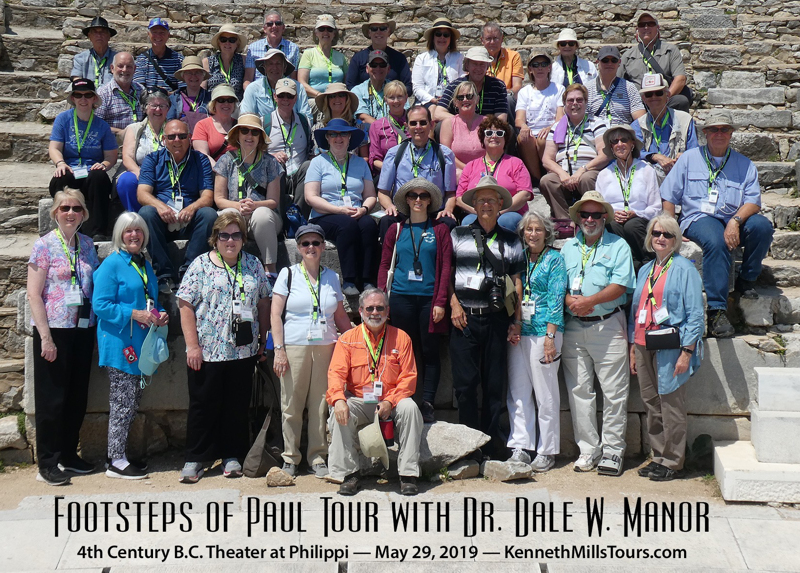
|
on Shutterfly or our 108 Photos with Captions on Facebook
|


 You may contact us at
You may contact us at